

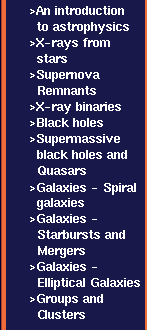
A place we can start is in interstellar space. Here large, diffuse clouds of dust and gas exist. They are not luminous at visible wavelengths but we see them either by light scattered from nearby stars (reflection nebulae) or by light transmitted through them from stars embedded within the clouds (emission nebulae). Some we see as just being dark against the general background of light from unresolved stars (dark nebulae). These clouds appear to be quite stable and yet they are also considered to be the clouds from which stars are born. Stars are much smaller and considerably more dense so some collapsing mechanism is required. So, why are these clouds stable and then not so stable? What is the force which opposes gravity initially and then later is not able to oppose gravity?
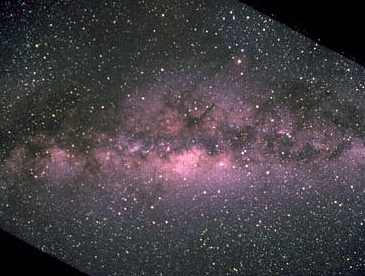
|
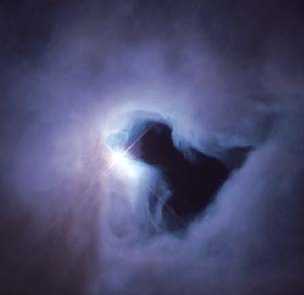
|
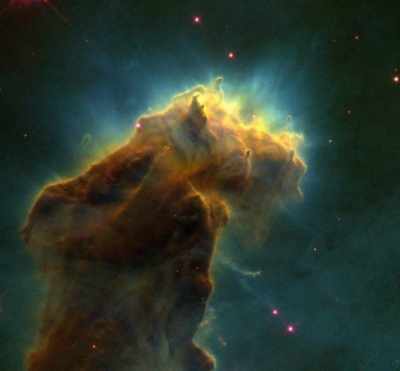
|
IMAGE - The Milky Way showing dark nebulae, a reflection nebula and an emission nebula
The simple answer to the first part is that the gas clouds are prevented from collapsing by their internal pressure; exactly the same kind of gas pressure you "put" into the tyres of your car. But this begs the question. Pressure is a sort of a force (it is the force per unit area) but we need to know what the forces actually are. We do not have to look very far because there are only 4 forces in nature of which gravity is one. Of the other 3 only the electromagnetic force and the nuclear force participate in providing the sorts of pressure we are considering.
In terms of our gas cloud the force which stops the atoms fusing together is the electromagnetic force. In a collision between atoms, the electrons which surround the nucleus first come into "contact"; like charges repel, and therefore provide an opposing force to gravity. In the same way when you are sitting in a chair, it is the electrons in your clothes which are repelled by the electrons in the chair which prevent you from falling "through" the chair.
As far as the gas is concerned, at non-zero temperatures (on the Kelvin scale) it always supplies a positive pressure which depends on the density of the gas and its temperature.
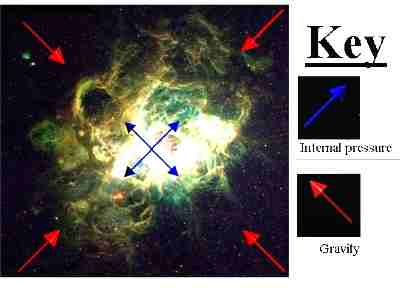
IMAGE - The forces at work in a nebula
The internal pressure counteracts the gravitational force
But any non-zero temperature body will radiate away a net amount of energy and so will cool . As it cools its internal pressure will decrease and therefore the cloud will shrink a bit. It can continue to do so until the net loss of energy is zero; that is, the energy it radiates of itself is replenished by the radiation it absorbs from its surroundings. This is the case with the interstellar clouds. They radiate energy but they also receive energy in the form of electromagnetic radiation from the surrounding environment. At this point they are stable.
How then does the cloud collapse to form stars? If the cloud can be forced (by some kind of gravity-assist force) to shrink just a little bit without the internal pressure rising, then the situation is taken out of balance in favour of gravity and gravity begins to take control. There are indeed some gravity-assist forces around but beyond the scope of this introduction.
But as the cloud collapses, gravitational potential energy is being released which then begins to heat up the gas. At the same time, because the cloud is now smaller, its density must be greater; hence its internal pressure has now increased to oppose the collapse. A new equilibrium is established with a smaller cloud which is hotter than before, especially in comparison with its surrounding environment. Therefore it radiates away net energy; its temperature drops, the internal pressure drops and the contraction continues.
This is essentially the underlying long term process by which stars evolve; matter goes from the less dense to the dense and from the cool to the hot. It undergoes some interesting excursions within that, but the overriding evolution just described is relentless in its overall direction.
The clouds we have been talking about are large on the local scale of size, up to 10 light years across. They are some of the most beautiful objects in the sky. As we said earlier, they are called nebula and are of three kinds, emission nebula, reflection nebula and dark nebula.

IMAGE - The Eagle Nebula
When nebulae do collapse, fragmentation occurs and clusters of stars can be formed. Once the relatively dense stars are formed they no longer participate in the continuing overall collapse of the gas cloud which is much less dense. If they were not falling directly towards the centre of mass of the cloud, they therefore have some angular momentum and hence end up orbiting the centre of mass of the cloud along with all the other stars in the cluster. Here we have another stable situation; the self-gravitational forces on the stars are balanced by their orbital motion (or the centrifugal forces). Newton's laws of motion tell us that matter, left to itself, will travel in a straight line and because of its mass it has momentum and inertia along that direction. This can be seen as a kind of opposing force to gravity. It is similar to the way a high-wire performer uses a long horizontal pole to keep his balance.
There are two basic kinds of cluster. The globular clusters are big and contain a large number of stars (of order of a million). They are typically about 30 light years across and therefore must have been formed out of truly enormous gas clouds; in fact it is thought that they were formed in the early stages of galaxy formation when the galaxies themselves were condensing out of the very much larger gas clouds which formed the protogalaxies. Globular cluster stars are amongst the oldest known objects in the Universe.
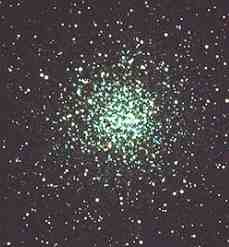
IMAGE - A globular cluster
This cluster contains many thousands of stars
The open clusters are very much smaller and contain just a few hundred stars. They are much younger and are sometimes referred to as the maternity ward for stars because it is in this way that stars are continuously being born. The open clusters are thought to form out of the dark nebulae. It is the motion of the stars in these clusters which prevent them from collapsing.
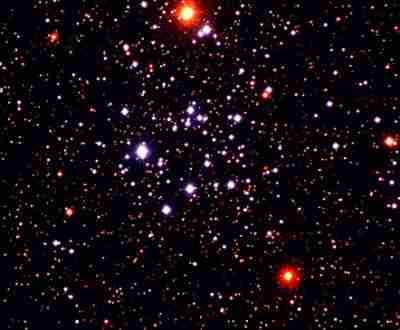
IMAGE - An open cluster
This cluster contains roughly one hundred stars
Stars can also be formed in smaller associations, that is in groups of just a few. Although we live next to a single star, about half the stars in the Universe are double stars, that is binary stars. It is interesting to think how different life might have been had the planet Earth been part of a binary system. We didn't miss it by very much; the masses of the giant planets Jupiter and Saturn are not so much less than a star.
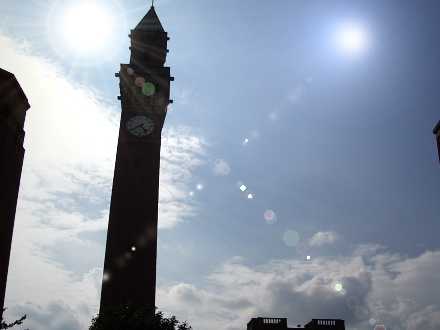
IMAGE - The University Birmingham when another Sun appeared!!
What it would be like living next to a binary star system
Again, the planets do not fall into the central star because of their orbital motion.

